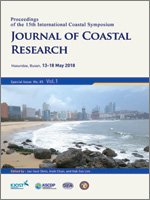Uranchimeg, S.; Kim, J-G.; Kim, J.-G.; Kwon, H.-H., and Lee, S.-O., 2018. A Bayesian Quantile Regression Approach for Nonstationary Frequency Analysis of Annual Maximum Sea Level in a Changing Climate. In: Shim, J.-S.; Chun, I., and Lim, H.S. (eds.), Proceedings from the International Coastal Symposium (ICS) 2018 (Busan, Republic of Korea). Journal of Coastal Research, Special Issue No. 85, pp. 536–540. Coconut Creek (Florida), ISSN 0749-0208.
Sea level rise is primarily caused by global warming and has been a key consideration in design practices in coastal engineering. The design of coastal structures is currently based on a frequency analysis of the local sea level under the stationary assumption, meaning that the maximum sea level will not vary significantly over time. However, the stationary assumption for sea levels might not be valid in a changing climate. In such a context, this study proposes a systematic approach to investigate nonstationarity in annual maximum sea levels (AMSLs) and offers estimates of design water levels for coastal structures using a non-crossing quantile regression-based nonstationary frequency analysis model within a fully Bayesian framework. The AMSLs for 20 tide gauge stations, each with more than 28 years of hourly records, are considered and compiled in this study. The nonstationarity in the AMSLs are explored by focusing on the change in the scale and location parameter of the probability distributions. The majority of the stations (three-fourths) are found to have an upward-convergent/divergent pattern in the distribution, and the distribution changes are confirmed by significance tests. This study determines an overly simple nonstationary frequency analysis (NSFA) approach with a time-dependent mean value might lead to underestimation of the AMSLs, which results in an increase the failure risk in coastal structures. A more detailed discussion of the characteristics of the distribution changes for the design water level is provided in the paper.





